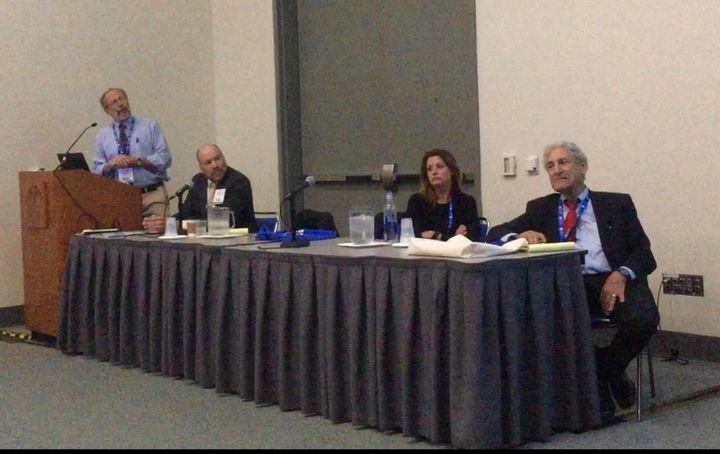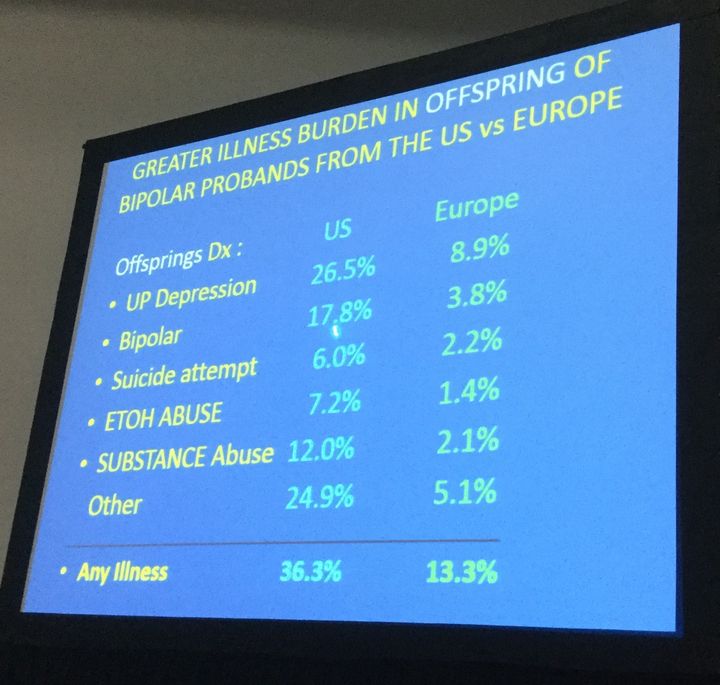Bipolar Disorder, called divine madness in ancient times, enters the era of genomics, proteomics and 21st century medicine. But the most important treatments remain surprisingly old-fashioned, according to experts who spoke at the American Psychiatric Association convention in San Diego on May 22. Marked by manic highs and low depressions, bipolar disorder affects approximately 3 percent of the population, and is not usually disabling. Ted Turner, author Kay Redfield Jamison, Winston Churchill and actress Patty Duke are among successful public figures with bipolar disorder.
The prestigious panel of experts was organized by Mark Frye, MD, Chief of Psychiatry at the Mayo Clinic. Speakers included Michael GItlin, MD, and David Miklowitz, PhD, of UCLA; Robert Post, MD, formerly of the National Institutes of Health; and Katherine Burdick, MD, of Harvard.
The experts confirmed that lithium, family focused therapy, and prevention should be primary treatments. New antipsychotics such as Seroquel are an expensive, increasingly common treatment for bipolar disorder, but are not as effective. The importance of treating low-level depression and cognitive problems was stressed.
Frye spoke about the importance of early diagnosis, and how new technologies could someday help. Genetic testing, brain imaging and saliva sampling may eventually identify patients who are at risk for developing bipolar disorder, as well as predict which medications will be useful. Frye and Joanna Biernacka have co-founded the Bipolar Disorder BioBank at the Mayo Clinic, for this purpose. Early diagnosis, for example, can prevent the prescribing of antidepressants to bipolar persons, which can cause Antidepressant Induced Mania, or AIM.
Gitlin focused on quality of life and functioning. "Even if they don't have symptoms, they're not doing much," Gitlin said of many recovered bipolar patients. Gitlin has led an unusually qualified career as a renowned researcher who has also maintained a practice and known patients across decades. Two years after an episode, he said, 98 percent of bipolar patients have no symptoms, but only about 60 percent have a decent quality of life. Bipolar disorder costs the nation $151-billion yearly, with 79 percent of these costs going to missed work days, disability, and lost productivity. Low-level depression, he said, may prevent persons from working or socializing, according to studies by his late colleague, Lori Altschuler, MD. He recommended that Nuvigil, Provigil, and stimulants such as Adderall and Ritalin can be used safely, without inducing mania, the way antidepressants might. Gitlin, referred to many studies by Frye (his former student, along with this author), confirming the safety of these medications for bipolar patients. Although Provigil is expensive and often not covered by health insurance, it can be purchased at Costco for $1 per pill.
Miklowitz spoke of the malignancy of critical families who make remarks such as, "Does she even realize that her crying keeps the rest of us awake all night?" or, "I resent her 'poor me' attitude." His group at UCLA performs Family Focused Therapy, or FFT, consisting of three modules: 1) Psychoeducation about the illness, medications, and sleep-wake cycles, 2) Communication and listening skills, and 3) Problem solving. FFT can prevent episodes of mania or depression, and might prevent bipolar disorder altogether.
According to Burdick, a specialist in the cognitive aspects of bipolar disorder, in 1898 the scientist Emil Kraeplin stated that bipolar disorder and schizophrenia are completely different illnesses. Since then, most research has focused on schizophrenia. Today however, records of 4-million families in Sweden indicate that schizophrenia and bipolar disorder tend to run in the same families. Therefore, according to Burdick, the same genes may be involved. Burdick specializes in studying cognition in bipolar disorder. She suggests that the CACNA1C gene, which regulates calcium, may be a common factor.
Post is one of psychiatry’s most revered researchers, and the former Chief of the National Institutes of Mental Health's Biological Psychiatry Branch. He prefaced his opinions by stating that he's less reserved, now that that he is retired from his government job.
"This is a malignant, metastasizing illness!" he said.
Post emphasized that bipolar illness should be treated like cancer, since each episode makes that illness worse. In fact, proper treatment at the first episode, can render the illness benign.
Regarding Family Focused Therapy, he said, "How many more studies do we need until we consider this a treatment for every freakin' patient?" Post also agreed with Burdick that the CACNA1C calcium influx gene maybe be associated with bipolar disorder. This is why calcium channel blockers such as nimodipine are effective treatments, as well as lithium.
Childhood abuse worsens bipolar disorder. Whereas bipolar disorder traditionally begins at a mean age of 26, abused children begin suffering the illness in half that time, at a mean age of onset of 13. In the US, two-thirds of bipolar disorder now begins prior to age 19.
Life in the US is far more stressful than in Europe, Post said, presenting startling data. In the US, the children of bipolar parents fare worse than their counterparts in Europe, in every way. Just 3.8 percent of European children of bipolar parents become bipolar, themselves. In the US, the risk is quintupled, with 17.8 percent of the children of bipolars becoming bipolar. The children of American bipolars are three times as likely to attempt suicide as their European counterparts (6 vs. 2.2 percent), and five times as likely to abuse alcohol (7.2 vs. 1.4 percent). Whereas 8.9 percent of children of bipolar parents in Europe suffer depression, 26.5 percent of their US counterparts suffer depression.
Post concluded by confirming that lithium remains the most tried, true and superior treatment for bipolar disorder. Even for the 97 percent of the population who is not bipolar, he stated that lithium prevents depression and bipolar disorder, reduces dementia, increases brain volume in the areas responsible for thinking and for memory (cortex and hippocampus), and even reduces the risk of cancer and neurological disorders.
Most of all, proper treatment with lithium with the first onset of bipolar disorder, can make the illness mild, altogether. Better yet, reducing childhood abuse and bullying, can prevent the illness, even in children with bipolar disorder in their genes.

Bipolar Disorder Experts Discuss What's Up: Michael Gitlin, Mark Frye, Katherine Burdick, Robert Post

Children of Bipolars fare worse in US than in Europe.